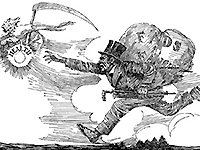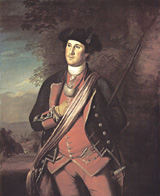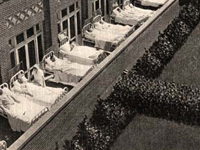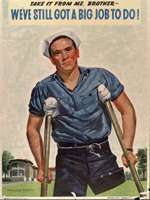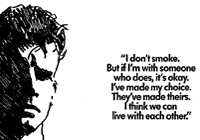1. Calomel, made popular by physician and patriot Dr. Benjamin Rush in the late 18th century, was perhaps the most commonly prescribed medicine through the first half of the 19th century. In the 1850s, it was recognized that the most important ingredient, which induced salivation and vomiting, poisoned patients over the long run. What was that ingredient?
b. Mercury. Specifically, Mercurous chloride, which, when acted on by stomach acid, freed the mercury and settled in the joints, loosened the teeth, inflamed the gums, and, with continued or heavy use, could result in mental debility and death.
2. Starting in the 1930s, shoe stores commonly measured children's feet with a new machine. This machine promised to ensure precise fitting of shoes, allowing children's feet room to grow properly. The machines were banned in the 1950s, however, because they used what to measure the feet?
b. X-rays. The shoe stores' young customers were directed to stand up against a cabinet and place their feet, still in their shoes, inside. An x-ray image of their feet inside their shoes could then be viewed on a screen.
3. In the 1920s and 1930s, manufacturers of consumer goods identified a new "rejuvenating" and "reinvigorating" ingredient that they added to face cream, lipstick, sunburn cream, toothpaste, and chocolate. Most of these products were made in Europe and imported into the U.S., but they were all eventually banned as health risks. What ingredient caused concern?
a. Radium. The Radior Company in London manufactured radium-impregnated foundation power and other radioactive cosmetics. French and German manufacturers sold radium toothpaste and chocolate and also used thorium in cosmetics.
4. Beginning in 1870, General Augustus J. Pleasanton (1808-1894) publicly promoted bathing in light of a specific color. Pleasanton and his advocates believed the light was a panacea which would cure most ailments and give people supernormal physical and mental powers. From 1875 to 1877, replacing clear glass windowpanes with glass panes tinted this color became a national craze. What color was it?
c. Blue. The "Blue Glass Cure" was the brainchild of Pleasanton, who wrote The Influence of the Blue Ray of the Sunlight and the Blue Colour of the Sky, in developing animal and vegetable life; in arresting disease, and in restoring health in acute and chronic disorders to human and domestic animals … in 1876.
5. From 1952 to 1956, manufacturer P. Lorillard sold its brand of Kent cigarettes with special "Micronite" filters. The filters were made of cellulose, acetate, and a third ingredient, intended to increase the cigarettes' ability to deliver less harmful smoke. Instead, this ingredient caused its own health concerns, leading Lorillard to discontinue its use. What was the ingredient?
a. Asbestos. Industrial workers mixed an especially pernicious form of asbestos with cellulose and acetate in huge machines to create Crocodilite fibers. Many of these workers later developed cancer.
6. From the 1860s and well into the 20th century, special belts were marketed to men. Designed to be worn around the waist (some with downward extensions), they were supposed to rejuvenate men who felt "weak" in some way. Magnets were sewn into the first belts, but by the 1880s, many belts used something else that aimed to "rejuvenate the flesh." What was it?
d. Electrical current. The first belts, with copper or silver discs sewn in, produced their weak current through soaking in salt water. Later belts used batteries to produce their current.
 For more on health in U.S. history (and the business, ethical and not, of medicine), search NHEC’s
For more on health in U.S. history (and the business, ethical and not, of medicine), search NHEC’s 